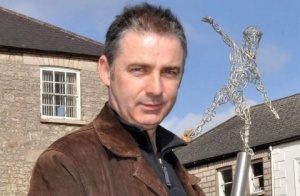Role: Sculptor
Company:
Track Record: Martin studied a BA Hons in Fine Art in Liverpool Polytechnic in 1989. His big break came some years later when he took up a residency on the Irwell Way Sculpture Trail, near Manchester.
What does your job involve?
The majority of my work involves design and production of work for public spaces. My aim is to make work that is site specific and relevant to its location. It is important public art encourages and stimulates interaction with the world around us. It should evoke a sense of pride and wonder for the unique quality of the places we live in, visit and work.
Have you always been interested in art?
Yes. I suppose from a very young age when first I discovered a book about the work of Picasso. My mother had acquired it and it was one of those books that gets put on a shelf and forgotten about!
It was a revelation to me. At school I had an interesting conversation with my career teacher who felt that I was wasting my time with art and it would not lead to a ‘proper job’. Inthe early 80s opportunities for artists were limited and coming from a Cookstown secondary school meant a long way to travel career wise.
What sort of training or qualifications do you have that have helped in your career?
I spent four years at Liverpool Polytechnic (now John Moores University) completing a BA Hons Degree in Fine Art in 1989.
Has it been difficult to make a living as a full time sculptor?
Sometimes it has been difficult. For the first few years after art college I worked in occupational therapy departments until I was offered the chance to undertake a six month residency on the Irwell Way Sculpture Trail near Manchester.
From then on it was a matter of taking as many opportunities as possible. Luckily I have been able to adapt my working practice to encompass a variety of sites, materials and processes. The nature of the majority of my work in public art means going through an application process. This can mean lots of interviews and presentations throughout the year as well as coming up with concrete ideas for art work. It is a very competitive field of work.
Who would generally be your clients — who would buy your work?
Nowadays I seldom produce work that is just for sale, via galleries etc. I tend to work to commission for public orgniasations such as local councils, corporate and private clients.
How did the public art project in Armagh city come about?
The project was widely advertised. I was informed of this project via Axis, an online resource and database of artists. Armagh City & District Council was asking for expressions of interest in the City Centre Public Art Programme.
The process involved providing an expression of interest, examples of previous projects, as well as CV. From following this, the artists made presentations to the Public Art Steering Group and selection panel.
Following this, I was informed that my concept, For the Love of Emer, was successful and would be commissioned.
Would your work normally be on such as large scale?
Not always, however my approach to art in public spaces means producing work that has relevance to the area and that achieves a scale that lends itself to the needs and spirit of the site.
In order to elevate the mind it is sometimes necessary to draw the eye upwards and away from our feet. It is not always necessary to work on a large scale to do this, however it is easy to lose a piece of sculpture within a streetscape or landscape.
What sort of personality or qualities do you need to be a full time artist?
Patience, perseverance, determination. Balancing the need to earn a living while producing work with integrity and passion. When working on large scale projects team work is essential. Although the artist is the vision maker, there are a whole team of people involved from the client/commissioner, project co-ordinators to fabricators and engineers.
What do you like to do when you are not working?
This is a difficult question: I am always working! Even when I’m doing things that aren’t specifically about art, I find most things relate to my work in some way.
I love watching movies and documentaries, making things with my children and reading. We are a busy, creative family: my wife is a writer and our children are home educated, so our time is pretty full.
Who or what has inspired you most in your career?
What inspires me most are people, events and stories that give magic and wonder to the world. Finding different ways to interpret what we see, what we hear and always, always questioning.
Who are your own favourite artists?
I like the work of lots of artists. It might be only one piece or virtually everything they have done. Artists like Rodin, Oisín Kelly, David Mach, Antony Gormley, Barry Flanagan, Rachael Whiteread, Lawrence Argent, Nigel Russell and Robert Hope to name but a few.
What advice would you give to someone keen to make art their career?
I would say that to work in the public realm getting experience is the key. Early career artists will find that it is difficult, because a good track record is important.
The ability to present well researched and thought out ideas that engage with people is paramount.


